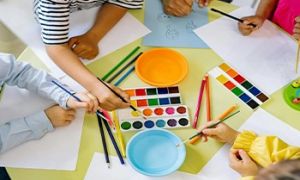Incorporating Indigenous resources into playspaces helps create a culturally rich and inclusive environment that fosters respect, learning, and connection to First Nations traditions. Here are some ways to modify playspaces meaningfully to incorporate Aboriginal and Torres Strait Islander resources.
1. Natural and Cultural Elements
- Use native plants to create sensory gardens that reflect Indigenous landscapes.
- Include rocks, logs, and sand to mimic traditional outdoor environments.
- Add Indigenous artwork or murals that tell cultural stories.
2. Yarning Circles and Gathering Spaces
- Design a Yarning Circle with seating made from natural materials.
- Use storytelling mats featuring Indigenous designs to encourage cultural learning.
- Create a quiet reflection space inspired by traditional meeting places.
3. Traditional Play and Learning Tools
- Introduce Indigenous games like throwing competitions or storytelling activities.
- Provide musical instruments such as clapsticks or didgeridoos for exploration.
- Use woven baskets for sensory play and sorting activities.
4. Language and Cultural Signage
- Display Indigenous language words for common objects in the play area.
- Include signs with Dreamtime stories to teach cultural narratives.
- Use symbolic pathways that represent Indigenous journeys and connections to Country.
5. Outdoor Learning and Bush Play
- Encourage nature-based play with bushwalking trails and water play areas.
- Set up fire pits (where safe) for cultural cooking experiences.
- Provide tools for traditional crafts, such as ochre painting or weaving.
For Babies and Toodlers
Modifying playspaces for babies to incorporate Indigenous resources can create a culturally rich and sensory-friendly environment. Here are some ideas:
1. Natural and Sensory Elements
- Use soft native plants for sensory exploration.
- Provide smooth stones, wooden objects, and woven baskets for tactile play.
- Introduce nature sounds (like birds or water) to create a calming atmosphere.
2. Indigenous Storytelling and Music
- Play traditional lullabies or Indigenous music for soothing sounds.
- Use story mats with Indigenous designs for tummy time and play.
- Introduce clapsticks or gentle drumming for rhythm exploration.
3. Cultural Textures and Materials
- Offer possum skin or woven fabric for sensory play.
- Use handmade Indigenous dolls or soft toys that reflect cultural heritage.
- Provide natural fiber blankets for comfort and connection to traditional materials.
4. Outdoor and Nature-Based Play
- Create a small bush garden with native plants for babies to explore.
- Use wooden play structures inspired by traditional designs.
- Encourage gentle water play to connect with natural elements.
For Preschoolers
Modifying playspaces for preschoolers to incorporate Indigenous resources helps create a culturally rich and inclusive environment. Here are some meaningful ways to do this:
1. Natural and Sensory Play Areas
- Use native plants to create sensory gardens that reflect Indigenous landscapes.
- Provide rocks, logs, and sand for open-ended play inspired by traditional environments.
- Include Indigenous artwork or murals that tell cultural stories.
2. Yarning Circles and Gathering Spaces
- Design a Yarning Circle with seating made from natural materials.
- Use storytelling mats featuring Indigenous designs to encourage cultural learning.
- Create a quiet reflection space inspired by traditional meeting places.
3. Traditional Play and Learning Tools
- Introduce Indigenous games like throwing competitions or storytelling activities.
- Provide musical instruments such as clapsticks or didgeridoos for exploration.
- Use woven baskets for sensory play and sorting activities.
4. Language and Cultural Signage
- Display Indigenous language words for common objects in the play area.
- Include signs with Dreamtime stories to teach cultural narratives.
- Use symbolic pathways that represent Indigenous journeys and connections to Country.
5. Outdoor Learning and Bush Play
- Encourage nature-based play with bushwalking trails and water play areas.
- Set up fire pits (where safe) for cultural cooking experiences.
- Provide tools for traditional crafts, such as ochre painting or weaving.
Further Reading
Incorporating Natural Materials In The Learning Environment
Incorporating Natural Elements In Outdoor Spaces
Importance Of Embedding ATSI Perspectives And Pedagogies
Walking Together







 As an Educator in Australia, your pay rate falls under the Children’s Services Award 2010. This award states the minimum amount that an employer can
As an Educator in Australia, your pay rate falls under the Children’s Services Award 2010. This award states the minimum amount that an employer can When working as a qualified Early Childhood Teacher (with a university degree) within a service, your rate of pay will come from the Educational Services
When working as a qualified Early Childhood Teacher (with a university degree) within a service, your rate of pay will come from the Educational Services When working as a Diploma Qualified Educator your pay rate is from the Children's Services Award 2010. This Award states your minimum rate of pay
When working as a Diploma Qualified Educator your pay rate is from the Children's Services Award 2010. This Award states your minimum rate of pay When working as a Cert 3 Qualified Educator, your pay rate is from the Children's Services Award 2010. This Award states your minimum rate of
When working as a Cert 3 Qualified Educator, your pay rate is from the Children's Services Award 2010. This Award states your minimum rate of Educational Leaders play a crucial role in their early childhood service by ensuring that the educational program aligns with best practices and supports the holistic
Educational Leaders play a crucial role in their early childhood service by ensuring that the educational program aligns with best practices and supports the holistic In early childhood education and care, ratios are more than a technicality—they are a frontline safeguard. Every child deserves responsive supervision, emotional connection, and developmental
In early childhood education and care, ratios are more than a technicality—they are a frontline safeguard. Every child deserves responsive supervision, emotional connection, and developmental Here’s a comprehensive Mobile Phone and Smart Watch Policy tailored for early childhood education and care (ECEC) services in Australia, aligned with the latest 2025
Here’s a comprehensive Mobile Phone and Smart Watch Policy tailored for early childhood education and care (ECEC) services in Australia, aligned with the latest 2025 With the new national child safety reforms kicking in on 1 September 2025, early childhood services like yours have a real opportunity to lead the
With the new national child safety reforms kicking in on 1 September 2025, early childhood services like yours have a real opportunity to lead the The Sea of Fish Challenge is a national initiative that invites children, educators, families, and communities to create and display fish artworks as a symbol
The Sea of Fish Challenge is a national initiative that invites children, educators, families, and communities to create and display fish artworks as a symbol Across the early childhood education and care sector, educators are sounding the alarm: current staffing ratios are insufficient to deliver safe, meaningful, and developmentally appropriate
Across the early childhood education and care sector, educators are sounding the alarm: current staffing ratios are insufficient to deliver safe, meaningful, and developmentally appropriate


